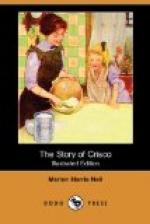Thick Rice Soup
2 pints water or stock Salt and pepper to taste 2 small onions 2 tablespoonfuls Crisco 1 cupful rice 1 cupful canned tomatoes, or 4 fresh ones
Wash and drain rice. Heat Crisco in saucepan, add rice and stir constantly until a golden brown. Now add water or stock, onions and tomatoes cut in small pieces, and seasonings. Cook slowly for one hour.
[Illustration]
FISH
Fish, though not quite so nutritious or so stimulating as butcher’s meat, is an excellent article of diet, as it is light and easy of digestion and well suited to delicate persons and those following sedentary occupations, who generally do not take exercise in the fresh air. Fish contains a fair proportion of flesh forming and mineral matter, and the white kinds very little fat, hence their value in a sick diet. A few fishes are rich in fat, as salmon, mackerel, eels, and herrings; they are more satisfying as a meal, but usually more difficult to digest, except the latter, which is fairly easy to digest, and, being inexpensive, forms an economical food.
The digestibility will vary also with the quality of the fish and the methods of cooking. White fish when boiled is improved by being rubbed over with a cut lemon, or by adding a little vinegar to the water in which it is cooked to keep it white and firm. The fish should be put into hot, not boiling water, otherwise the higher temperature contracts the skin too quickly, and it breaks and looks unsightly. Salt fish may be placed in cold water, then boiled to extract some of the salt; if the fish has been salted and dried, it is better to soak it in cold water for about twelve hours before cooking.
Fish to be fried should be cooked in sufficient hot Crisco to well cover it, after having been dried and covered with batter, or with beaten egg and breadcrumbs. To egg and breadcrumb fish put a slice into seasoned flour, turning it so that both sides may be covered. Shake off all loose flour. Brush fish over with beaten egg. Raise fish out of egg with the brush and a knife, drain off egg for a second, and lay fish in crumbs. Toss these all over it, lift out fish, shake off all loose crumbs, lay the slice on a board, and press crumbs down, so that surface is flat. The thicker the fish the more slowly it must be fried after the first two minutes, or it will be raw inside when the outside is done.
[Illustration]
To bone fish. The process of boning is known as filleting and is generally done by the fish dealer, but when this is not the case the single rule for boning must be strictly adhered to in order to keep the knife on the bone lifting the flesh with the left hand while the knife slips in between the bone and the flesh. Flat fish are divided down the middle of each side well into the bone, and the boning is begun at either side of the incision. Round fish are cut down the back, the flesh is laid open from one side and the bone is removed from the other. Occasionally round fish are boned readily, the whole fish minus the bones being returned to its proper shape, as in anchovies, sardines, herrings, haddocks, etc., in this case the fish would be split down the front, not the back, and stitched together after boning.




